

7/2006
AIA firm led pro bono effort; library to be a neighborhood beacon of hope

by Russell Boniface
Associate Editor
The Art Deco Alvar Street Branch Library, a New Orleans landmark damaged by Hurricane Katrina, has been restored to its original form by a pro bono team led by Minneapolis-based Meyer, Scherer & Rockcastle, Ltd. (MS&R). Dedication and effort by combined forces enabled the project to be completed in a mere four months, with the library re-opening June 25. The Alvar Street Branch Library, listed on the National Register of Historic Places, is one of the first damaged libraries brought back into service in New Orleans since the monster storm.
 In addition to its architectural recovery, the small, 2,550-square foot
Art Deco structure is expected to culturally reconnect the historic and
diverse Bywater Neighborhood, located in the city’s east section.
MS&R collaborated with Library Journal, a leading library industry
trade magazine, the New Orleans Public Library, and book and media distributor
Baker & Taylor. Together the team solicited and received pro bono
help from many businesses, securing donations valued at more than $500,000.
In addition to its architectural recovery, the small, 2,550-square foot
Art Deco structure is expected to culturally reconnect the historic and
diverse Bywater Neighborhood, located in the city’s east section.
MS&R collaborated with Library Journal, a leading library industry
trade magazine, the New Orleans Public Library, and book and media distributor
Baker & Taylor. Together the team solicited and received pro bono
help from many businesses, securing donations valued at more than $500,000.
The little library stood its ground
The white concrete exterior of the monolithic Alvar Street Branch Library,
built in 1940, withstood the winds of Hurricane Katrina, but not several
feet of flood waters that stood stagnant inside the structure for weeks.
Most of the interior was decimated, including furniture, flooring,
shelving, and the electrical and computer systems. The entire book
and media collection was destroyed. But its concrete, boxlike structure
remained firm.
All 13 library branches in New Orleans sustained damage that included flooding, blown off facades, damaged roofs, and broken windows, resulting in destroyed books, floors, furniture, and computers. In another part of the city, the Martin Luther King Branch was completely destroyed. The library system was so ravaged that it had to lay off 90 percent of its employees after the hurricane. The Alvar Branch is only the fifth library of the 13 branches to be fully restored, while other branches have only partial services or are closed indefinitely.
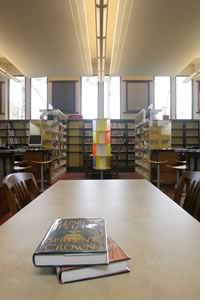 The Alvar Street Branch itself is a historic community landmark. Designed
by city architect Maurice B. Depass, it once faced an open green space
known as McCarty Square, a large, public park that served as a hub for
neighborhood recreation in the late 19th and early 20th century, as well
as the focal point for a number of fine homes.
The Alvar Street Branch itself is a historic community landmark. Designed
by city architect Maurice B. Depass, it once faced an open green space
known as McCarty Square, a large, public park that served as a hub for
neighborhood recreation in the late 19th and early 20th century, as well
as the focal point for a number of fine homes.
Starting a return to normalcy
MS&R wanted to renovate the Alvar Street Branch Library to help rebuild
the diverse Bywater Neighborhood, which only now is starting a return
to normalcy in its post-Katrina recovery. The renovated library is meant
to be a place for the community to connect. In addition to its design
services, MS&R secured all furniture and computer donations estimated
at more than $150,000, as well as private donations exceeding $25,000.
MS&R has worked on over 100 libraries.
 Paul Mellblom, AIA, MS&R principal, explains that the four-month
project timeframe for Alvar was aimed at having it re-open in time for
last month’s American Library Association (ALA) conference in New
Orleans. “It was the first large conference to come back to the
city since Katrina,” Mellblom says. “We looked at the Alvar
Branch because structurally, the shell of the building was in good condition.
The walls, roof, and floor are made of very thick concrete, plus the
roof had been replaced not too long ago. It is a good building envelope
that proved it could withstand winds and water intrusion. And it was
small enough to get it open for the ALA conference.”
Paul Mellblom, AIA, MS&R principal, explains that the four-month
project timeframe for Alvar was aimed at having it re-open in time for
last month’s American Library Association (ALA) conference in New
Orleans. “It was the first large conference to come back to the
city since Katrina,” Mellblom says. “We looked at the Alvar
Branch because structurally, the shell of the building was in good condition.
The walls, roof, and floor are made of very thick concrete, plus the
roof had been replaced not too long ago. It is a good building envelope
that proved it could withstand winds and water intrusion. And it was
small enough to get it open for the ALA conference.”
Mellblom, a graduate of Tulane University in New Orleans, immediately volunteered for the Alvar project. “It was a personal way to get involved and give something back. When I went back, the city was oddly quiet, but it was great to see normalcy in portions of the city. But in other areas, it’s just block and block of houses completely ruined—you look at it and ask, ‘How could this have happened in this country?’ It is utter devastation as far as you can see. And there is a veneer of mud everywhere that tells you something horrible happened that, I think, adds finality to it. What you saw on the evening news didn’t do it justice.”
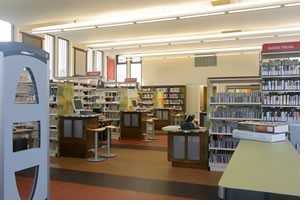 Not just about books
Not just about books
Mellblom says that a surprising number of people are returning to the
Bywater neighborhood, adding to his conviction that restoring Alvar
was critical for the community. “It is needed. This is a neighborhood
that is returning. People are feeling a renewed optimism. The restored
library will be a community center and beacon of hope and aspiration.
In a tangible sense, we used this project as an opportunity to recreate
the library for the 21st century. It will be a place for families to
come back together, but it will also be a place to get books and access
services on the Internet.”
But before they brought in the computers, something first had to be done about the library’s bookshelves, which had been sitting in standing water for weeks. “Despite two feet of standing water inside, the building was still in good condition, but its interior, including the metal shelving and books, were ruined,” he describes. But a key element of the interior structure could be saved: its original solid, red gum wood shelving. It was important to Mellblom that he restore it for the community. “A beautiful red gum wood book shelf system went around the perimeter of the library. It withstood sitting in water, but needed to be stripped and refinished to make it beautiful once again, especially since nothing had ever been done to it before.”
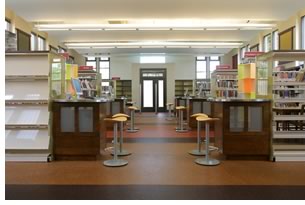 Next came the technology and the new white, metal bookshelves. “We
put in 22 computer stations with flatscreen monitors in the center aisle
by separating the metal bookshelf stacks and placing a table with a computer
on it at the end of each stack, as to create small rooms. The building
is so small there is no opportunity for separate meeting and study rooms,
so the bookshelf stacks create that space separation.
Next came the technology and the new white, metal bookshelves. “We
put in 22 computer stations with flatscreen monitors in the center aisle
by separating the metal bookshelf stacks and placing a table with a computer
on it at the end of each stack, as to create small rooms. The building
is so small there is no opportunity for separate meeting and study rooms,
so the bookshelf stacks create that space separation.
 “On
the other end of the stacks we incorporated art work on the end panels
from local artists depicting New Orleans jazz musicians.” Native
New Orleans jazz artists Louis Armstrong, Jelly Roll Morton, and Sidney
Bechet are among the musicians featured on the end panels. Mellblom thinks
the jazz theme sends an important message about aspiration. “People,
especially kids, can come in and see the images of the city’s successful
jazz musicians, and then they can imagine!
In addition, we put up acoustical panels with different color fabric
between the windows, but the goal is to have the fabric removed so local
artists can put up silkscreens of their work. It is a way for the neighborhood
to appropriate the library, and for the library to reflect the local
values and people of the neighborhood.”
“On
the other end of the stacks we incorporated art work on the end panels
from local artists depicting New Orleans jazz musicians.” Native
New Orleans jazz artists Louis Armstrong, Jelly Roll Morton, and Sidney
Bechet are among the musicians featured on the end panels. Mellblom thinks
the jazz theme sends an important message about aspiration. “People,
especially kids, can come in and see the images of the city’s successful
jazz musicians, and then they can imagine!
In addition, we put up acoustical panels with different color fabric
between the windows, but the goal is to have the fabric removed so local
artists can put up silkscreens of their work. It is a way for the neighborhood
to appropriate the library, and for the library to reflect the local
values and people of the neighborhood.”
The library now has various shades of orange, brown, and red on a recycled rubber floor. The inside of the wood bookshelves is celery green, matching parts of the end caps and some of the acoustical panels. Other bright colors highlight the furniture. The overall effect gives the open space a colorful quality that coincides with the brightness of the new overhead lighting, the white metal bookshelf stacks, and the natural light coming through the many windows. “The library’s interior is one large open space, so we wanted to give it very vibrant colors, especially since New Orleans is a very vibrant city.”
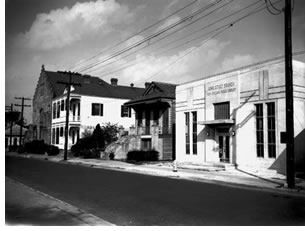 In addition to a new electrical system, there is geometrically shaped
furniture, an expanded kitchen and staff lounge, new gathering spaces,
and an additional bathroom. To fill the bookshelves, Baker & Taylor
acquired 12,000 donated books, audiobook CDs, DVDs, and music CDs from
many publishing houses. Completing the project is an exterior courtyard
to host community gatherings and receptions.
In addition to a new electrical system, there is geometrically shaped
furniture, an expanded kitchen and staff lounge, new gathering spaces,
and an additional bathroom. To fill the bookshelves, Baker & Taylor
acquired 12,000 donated books, audiobook CDs, DVDs, and music CDs from
many publishing houses. Completing the project is an exterior courtyard
to host community gatherings and receptions.
A phenomenal experience
For Mellblom, the Alvar project was very rewarding. “Every library
is significant, but Alvar is probably one of the most significant I’ve
worked on because the need for it was so obvious and compelling. It was
a blessing to have been involved in the project, and I am grateful we
were asked. It was absolutely a phenomenal experience. The gratification
of having participated in it is in some ways indescribable. I really
feel like I did something unique and wonderful in my career. Plus it
was a perfect example of everyone coming together with a common goal
and working together to make it succeed.”
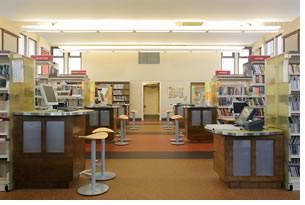 In the bigger picture, Mellblom points out the important need for libraries
in our society. “A library is a democratic place where people are
equal. A library is a portal to knowledge, information, and aspiration.
Its place in a community infrastructure is critical for the well being
of a community. But a library is also critical for people who are reforming
a community. While you need grocery stores, banks, and a post office,
libraries and parks are what really make living in a place much more
wonderful.”
In the bigger picture, Mellblom points out the important need for libraries
in our society. “A library is a democratic place where people are
equal. A library is a portal to knowledge, information, and aspiration.
Its place in a community infrastructure is critical for the well being
of a community. But a library is also critical for people who are reforming
a community. While you need grocery stores, banks, and a post office,
libraries and parks are what really make living in a place much more
wonderful.”
Mellblom is optimistic about the rehabilitation of the Bywater neighborhood. “There is still substantial damage there, but people are actively rehabilitating the neighborhood. There is still much work to be done, but there is a lot of neighborhood integrity there. Bywater is returning.”
Copyright 2006 The American Institute of Architects.
All rights reserved. Home Page ![]()
![]()
![]()